
Welcome to Hyperion Records, a British classical label devoted to presenting high-quality recordings of music of all styles and from all periods from the twelfth century to the twenty-first.
Hyperion offers both CDs, and downloads in a number of formats. The site is also available in several languages.
Please use the dropdown buttons to set your preferred options, or use the checkbox to accept the defaults.

The limitation of such literary parallels is immediately apparent at the start of the First Ballade. Remarkable when first written, the opening musical arch seems scarcely less original today. The rapid loss of confidence after such a resplendent introduction and the transformation of the subdued first and second subjects into outbursts of passionate declamation and song could never be reduced to a satisfying verbal equivalent, however subtle or distinguished. The cadences which conclude each phrase of the first subject are left unresolved and it takes a lengthy and agitated elaboration to resolve such unease in the assuaging second subject in E flat major. However, the music remains pensive and wistful, and only a further and triumphant shift into A major fully erases all doubts and questions. Blazing octaves lead to a capricious waltz-like variation, mischievously spiced and syncopated before a sudden descent returns us to both the principal subjects. These culminate in a coda introduced Il più forte possibile and marked Presto con fuoco. Ricocheting figuration leads to boiling scales and dramatic, recitative-like interjections before a plunge reinforced with grace notes and a mixture of contrary motion and unison octaves.
from notes by Bryce Morrison © 2004
Les limites de tels parallèles littéraires apparaissent d’emblée avec le début de la Première Ballade. Si l’arche musicale initiale semblait remarquable lorsqu’elle fut écrite, elle ne l’est pas moins encore de nos jours. La rapide perte de confiance ressentie après une introduction aussi resplendissante et la transformation des premier et second thèmes retenus en des éclats déclamatoires et des chants passionnés ne sauraient se réduire à un équivalent verbal, aussi subtil et distingué puisse-t-il être. Les cadences qui concluent chaque phrase du premier thème demeurent sans résolution. Le second thème en mi bémol majeur requiert une longue élaboration agitée pour résoudre un tel malaise. Pourtant, la musique demeure pensive et nostalgique. Seule une modulation ultérieure et triomphante en la majeur permet d’effacer les doutes et les questions. Des octaves enflammées conduisent à une variation aux allures de valse capricieuse, malicieusement épicée et syncopée, avant qu’un mouvement descendant soudain ne rappelle les principaux thèmes. L’intensité culmine dans la coda introduite Il più forte possible notée Presto con fuoco. Des figurations ricochent et conduisent à des gammes bouillonnantes pleines de drame, à des interjections ressemblant à des récitatifs, et pour finir à un plongeon renforcé par des notes de grâce et un mélange de mouvements contraires et d’octaves à l’unisson.
extrait des notes rédigées par Bryce Morrison © 2004
Français: Isabelle Battioni
Die Grenzen solch literarischer Parallelen werden sofort zu Anfang der ersten Ballade deutlich. Der musikalische Bogen am Anfang des Stückes war schon zur Entstehungszeit des Stückes außergewöhnlich und scheint auch heute kaum weniger originell. Der rapide Verlust an Zuversicht nach einer solchen glänzenden Einleitung und die Verwandlung des gedämpften ersten und zweiten Themas in Ausbrüche leidenschaftlicher Deklamation könnten niemals auf ein befriedigendes verbales Äquivalent reduziert werden, sei es noch so subtil und elegant. Die Kadenzen, die jede Phrase des ersten Themas abschließen, bleiben unaufgelöst und erst nach einer langen und erregten Ausführung kann die Beklemmtheit durch das beschwichtigende zweite Thema in Es-Dur gelöst werden. Die Musik bleibt jedoch nachdenklich und schwermütig und erst nach einem weiteren, triumphierenden Wechsel nach A-Dur werden alle Zweifel und Fragen getilgt. Furiose Oktaven leiten hinüber zu einer eigenwilligen, walzerartigen Variation, die spitzbübisch gewürzt und synkopiert wird, bevor ein plötzlicher Abstieg zu den beiden Hauptthemen zurückführt. Diese kulminieren in einer Coda die Il più forte possibile beginnt und mit Presto con fuoco überschrieben ist. Eine federnde Figuration führt zu tobenden Tonleitern und dramatischen, rezitativartigen Einwürfen, bevor ein Sprung stattfindet, der von Verzierungen sowie einer Mischung aus gegen- und gleichläufigen Oktaven verstärkt wird.
aus dem Begleittext von Bryce Morrison © 2004
Deutsch: Viola Scheffel
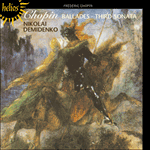 Chopin: Ballades & Sonata No 3 Chopin: Ballades & Sonata No 3‘Lovely playing which I enjoyed from first note to last for its poetry and passion as well as seemingly effortless keyboard fluency and command’ (Gram ... ‘The Scherzo is as light as gossamer and the finale has both a heroic sense of struggle and passages of the most delicate filigree. Demidenko keeps yo ...» More |
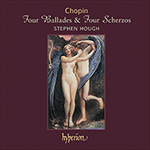 Chopin: Four Ballades & Four Scherzos Chopin: Four Ballades & Four ScherzosHere is some of the finest piano music to have come out of the nineteenth century, and in a recording which finds Stephen Hough on top form: ‘It’s not given to many to play them as well as he. Hough is unfailingly thoughtful; there’s not a note th ...» More |
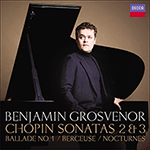 Chopin: Piano Sonatas Nos 2 & 3 Chopin: Piano Sonatas Nos 2 & 3Described in 1840 by Robert Schumann as comprising ‘four unruly children smuggled under this name into a place they could not otherwise have penetrated’, Chopin’s Piano Sonata No 2 is now a stalwart of the repertoire, and for this new recording by ...» More |
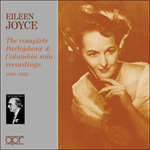 Eileen Joyce - The complete Parlophone & Columbia solo recordings Eileen Joyce - The complete Parlophone & Columbia solo recordings‘Listening to Joyce is strangely addictive. One cannot wait, as it were, to read the next chapter. She shares with Kreisler and Tauber the same unteac ... ‘The quality that comes across in these performances is the sheer joy of playing. Joyce possessed a formidable technique and an interpretative mind th ...» More |
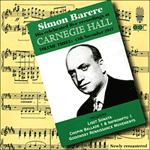 Simon Barere – His celebrated live recordings at Carnegie Hall, Vol. 3 - 11 November 1947 Simon Barere – His celebrated live recordings at Carnegie Hall, Vol. 3 - 11 November 1947 |

